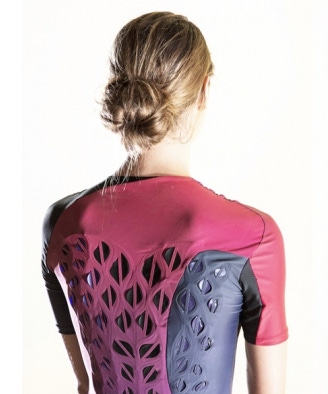Nonpathogenic E. coli cells open and close ventilation flaps in sports attire when you work up a sweat.
May 23, 2017

Mention of E. coli in an article is almost always an ill omen. Not this time, though, especially if you’re a gym rat or athlete looking for the next great thing in workout attire that adjusts to body temperature and sweat. Researchers at the Massachusetts Institute of Technology (MIT) have developed a biofabric lined with a nonpathogenic strain of E. coli that swells and shrinks in response to changes in humidity. The breathable workout suit is fitted with ventilating flaps that open and close depending on the wearer’s body heat and sweat. That action is driven by the live E. coli cells, which act as the flaps’ sensors and actuators. A paper published in Science Advances highlights the technology.
|
Image courtesy Hannah Cohen/MIT. |
The living microbial cells, which the researchers assure us are safe to touch and even consume, were printed onto sheets of latex that were exposed to changing moisture conditions. “When the fabric was placed on a hot plate to dry, the cells began to shrink, causing the overlying latex layer to curl up,” explained a press release on the MIT website. “When the fabric was then exposed to steam, the cells began to glow and expand, causing the latex to flatten out. After undergoing 100 such dry/wet cycles, the fabric experienced “no dramatic degradation” in either its cell layer or its overall performance, according to Wen Wang, the paper’s lead author and a former research scientist in MIT’s Media Lab and Department of Chemical Engineering. In addition to responding to moisture, the cells have been engineered to light up in the presence of humidity, incorporating a safety feature if, for example, you’re running at night.
This technology has been adapted to a wearable garment, with the size and aperture capability of each flap tailored to areas of the body where heat and sweat are generated. “We redesigned the garment using a fusion of heat and sweat maps to, for example, make flaps bigger where the body generates more heat,” explained graduate student Lining Yan.
During tests of the garment, its flaps started opening up right around the time when participants reported feeling warm and sweaty, according to the researchers. Sensor readings confirmed that the flaps effectively removed sweat from the body and lowered skin temperature, more so than when participants wore a similar running suit with nonfunctional flaps.
Wang tested the suit herself, and found that the flaps created a welcome sensation. After pedaling hard for a few minutes, Wang recalled that “it felt like I was wearing an air conditioner on my back.”
The fabric has also been integrated into a prototype running shoe, which works in a similar manner. The flaps open up and fluoresce as the humidity increases and close and fade in dry conditions.
The research team is looking to collaborate with sportswear companies as well as manufacturers of curtains and bedsheets to commercialize the moisture-responsive technology. Wang also cites the potential of a “second skin” in a new genre of responsive packaging.
Wang’s co-authors include 14 researchers from MIT, specializing in fields including mechanical engineering, chemical engineering, architecture, biological engineering, and fashion design, as well as researchers from New Balance Athletics. Wang co-led the project, dubbed bioLogic, with former graduate student Yao as part of MIT’s Tangible Media group, led by Hiroshi Ishii, the Jerome B. Wiesner Professor of Media Arts and Sciences.
Biologic from Tangible Media Group on Vimeo.
About the Author(s)
You May Also Like




